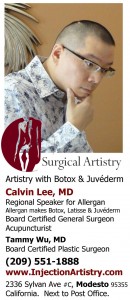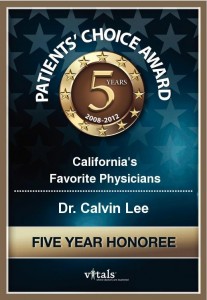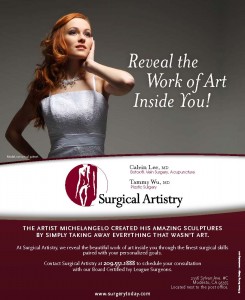I felt compelled to write a little bit on this subject. I have been a breast cancer surgeon and have worked together with my wife, Dr. Tammy Wu on breast reconstruction after I had done the breast cancer operation. In fact, part of my dream, which has somewhat died, was to create a breast cancer center. The same kind that Angelina Jolie had gone to for her treatment. It involves many breast cancer specialists under the same roof.
I had been one of the first surgeons in Modesto to bring sentinel lymph node technology to breast cancer surgeries. I had helped certify my other surgical partners at a group which used to be called McHenry Medical Group. We were a group of 6 surgeons at the time. This was the group that brought me to Modesto, CA. I also had been trained to perform skin sparing mastectomies. Dr. Wu and I have performed several of these procedures together here in Modesto. Dr. Wu would assist me in these procedures and then I would assist her in the reconstruction. However in 2006, we made a decision to move Surgical Artistry more toward a cosmetic surgery – only – focus.
Angelina Jolie’s surgery used sentinel lymph node technology, nipple sparing mastectomy techniques, and then followed up by breast reconstruction with tissue expanders and then with what I believe are anatomically shaped implants – possibly the implants that we have just been blogging about – the new gummy bear breast implants – approved in February of this year. Dr. Wu has been familiar with all aspects of Angelina Jolie’s breast reconstruction with expanders and implants.
But what is new to me, as a general surgeon who backed off from breast cancer surgery in 2006 is: The nipple delay procedure – I think this is genius!. This procedure is usually done when patients have had previous augmentation or when there is fear of cancer hiding underneath the nipple area, and also for improving nipple/areolar survival after mastectomies. The blood supply is improved. Dr. Tammy Wu explained to me that this idea is also done in plastic surgery procedures such as TRAM flaps – where a extraneous blood supply is cut off first and then a waiting period is done to have the rest of the blood supply improve – before performing the full surgery. And I have never performed a double mastectomy. I have received three requests (that I can remember) for this in my breast cancer surgery career, but I have turned all three of them down, but recognizing that it is a patient’s choice. I have hooked them up with other surgeons. I felt somewhat uncomfortable removing the mastectomies. Not all of these patients has had definitive BRCA testing and at the time, and I would say that BRCA testing was newer back in the early 2000’s. Thus some of these requests were based on just “disliking breast cancer” and wanting to “reduce breast cancer risk.” But I know that breast cancer risk is present even after I do a mastecomy (meaning breast removal). Why? Because inevitably, I will leave some breast tissue behind, and much of the breast tissue left behind is in the nipple/areolar complex. And even if I take the nipple/areolar complex (which is the standard mastectomy), I would leave some tissue and cells behind – especially on the skin flap. If I made it too thin, the skin flap above could die. Thus, I felt uncomfortable, personally, removing normal breasts – even though I knew I was married to someone who could reconstruct them very well. So even if I removed them, the risk of cancer was still there. Essentially I was thinking that I would reduce a woman’s general risk of breast cancer from 10% (this was the figure I used back then), down to about 5%. It wasn’t worth it for me. But with BRCA testing, it is a different story as you read below (the risk reduction is greater because you start at a higher number BRCA mutation positive risk – 87% per Angelina Jolie’s doctors). So perhaps if I was practicing breast cancer surgeries today, I would be more “comfortable” with performing prophylactic double mastectomy (which is what Angelina Jolie received).
Angelina’s surgery – is public – as she wanted it, and in this blog I paraphrase highlights from Angelina’s general surgeon (breast surgeon). I think it is wonderful that she is sharing and I think she made a good decision based on the knowledge that is available.
In Summary of Angelina’s surgery:
My one sentence summary of her recent breast surgeries from February 2013 to May 2013:
With a known BRCA1 genetic mutation, Angelina Jolie underwent a prophylactic nipple sparing double mastectomy with sentinel lymph node marking after passing a nipple delay surgery procedure, and then had a staged plastic surgery breast reconstruction procedure involving breast expanders and implants.
- She underwent genetic testing.
- She was diagnosed as being BRCA1 mutation positive.
- She had her surgery done in California at a breast center / surgery center.
- She had a technique done callled nipple delay.
- She then underwent prophylactic double mastectomy with nipple sparing surgery
- She had sentinel lymph node identification done, but not removed – this is in case she gets cancer in the area of her mastecomies in the future.
- She had breast reconstruction with her plastic surgeon, first with expanders to stretch the skin envelope then with breast implants.
BRCA – a part of overall Breast Health
5/18/13
First, what does BRCA stand for?
BRCA stands for BReast CAncer susceptibility gene. There are two of these genes identified #1 and #2. thus the designation BRCA1 and BRCA2
What is BRCA?
- BRCA1 and BRCA2 are tumor suppressor genes.
- In normal cells, BRCA1 and BRCA2 help stabilize DNA and prevent uncontrolled cell growth.
- Mutation of BRCA1 and BRCA2 has been linked to hereditary breast and ovarian cancer.
- A woman’s risk over her lifetime of developing breast and/or ovarian cancer is much increased if she inherits a harmful mutation in BRCA1 or BRCA2.
- the percentage of people in the general U.S. population that have any mutation in BRCA1 has been estimated to be between 0.1 – 0.6 percent.
Mutations of BRCA1 vs BRCA2
In addition to risk of breast and ovarian cancer BRCA1 and BRCA2 have additional cancer risks to other organs see list below.
BRCA1 mutations may have additional risk of these cancers
- cervical
- uterine
- pancreatic
- colon cancer
BRCA2 mutations may have additional risk of these cancers
- pancreatic
- stomach
- gallbladder
- bile duct
- melanoma
Angelina Jolie’s Mastectomy and her article in NY times.
- She had a positive test for the BRCA1 mutation
- She underwent double prophylactic mastectomy
- Angelina Jolie’s Op-Ed contribution to the New York Times on May 14, 2013.
- She explains that, she had a 87% risk of breast cancer and a 50% risk of ovarian cancer, according to her doctors.
- Only a fraction of breast cancers have the BRCA1 gene mutation.
- Those with the BRCA1 gene have a 65% risk of getting breast cancer on average.
- On April 27, 2013 she finished three months of medical procedures which involved the mastectomies.
- She chose to have bilateral prophylactic mastectomies, meaning removal of both breasts, preventative – without having the disease yet.
- On Feb 2, 2013, she did a procedure known as “nipple delay” which rules out disease in the breast ducts behind the nipple and draws extra blood to the area. It is a study which can increase the chances of saving the nipple.
- 9 weeks later, she had mastectomy with implant reconstruction.
- She says that her risk of developing breast cancer drops from 87% to under 5%.
- A primary motivator for her surgery, she says, is so that her children don’t have to fear losing her to breast cancer.
- The cost of testing for BRCA1 and BRCA2 is more than $3000 in the USA.
- She chose not to keep her story private.
Angelina Jolie’s Surgeon, Dr. Kristi Funk Blogs on May 14, 2013:
- Emphasizes that each woman’s case is different. Surgery will not necessarily be the right choice for everyone. The important thing is to be aware of your options.
- Approximately 5-10% of all breast cancers and 14% of ovarian cancers occur from a BRCA1 or BRCA2 genetic mutation that is inherited from either parent.
- Women carrying either a BRCA1 or BRCA2 mutation have up to a 87% lifetime chance of breast cacer and a 54% chance of Ovarian cancer.
- General population (all comers), there is a 12% risk of breast cancer and less than 1% risk for ovarian cancer.
- In the general population the risk for a BRCA mutation is 1-500 (.2%) people but those of Ashkenazi Jewish heritage it is 1 in 40.
- In those who BRCA-1 carriers who get breast cancer, 85% will have a more aggressive “triple negative” subtype (vs. 15% of general population). Triple negative breast cancers mean ER/PR negative and Her2 – normal.
- 8 red flags that indication a possible BRCA mutation:
- 1st, 2nd, or 3rd degree relatives from mother or father, with breast cancer before age 50 or ovarian cancer at any age
- Ashenazi Jewish Heritage (Easter European)
- Male relative with breast cancer
- Any relative who is a known BRCA mutation carrier
- Breast cancer in self before age 50 – early onset.
- Two breast cancers in self, at any age
- “Triple negative” breast cancer in self.
- 2 or more family members with Breast, Ovarian, Pancreas, Prostate, Melanoma, Uterine, Colon, and Stomach Cancers.
- There exists non-BRCA inherited genetic mutations associated with breast and ovarian cancer as well.
- Feb 2, 2013, Angelina had her first operation, the nipple delay.
- Feb 16, 2013, Mastectomy with Sentinel Nodes Identification – not removed – but dyed.
- Her plastic surgeon was Dr. Jay Orringer, assisted by her breast cancer surgeon Dr. Kristi Funk – the writer of the blog which I’m paraphrasing from in this section.
- April 27, 2013, 10 weeks after the mastectomies, she received reconstruction of the breasts with implants.
What is Nipple Delay Surgery?
- Considered when the nipple is thought to be at risk for either cancer disease or inadequate blood supply.
- This is performed 1-2 weeks before the mastectomies.
- The incision used is the planned mastecomy incision.
- The small disc of tissue behind the nipple and areola is removed and sent for pathologic diagnosis – to rule out the presence of cancer. If cancer is present in this area, then nipple sparing/areolar sparing mastecomy would be contraindicated.
- This procedure could bring extra blood flow to the nipple aream lessening the chances of nipple and skin loss after nipple sparing/areolar sparing mastecomy.
- This is similar to the delay procedure performed by plastic surgeons : My wife says: “In Tram Flaps we cut off the inferior blood supply to the rectus muscle to allow the remaining blood supply to get used to taking over – this strengthens the remaining blood supply and in about 2 weeks the remainder of the surgery is done for breast reconstruction.”
How does this relate to us at Surgical Artistry?

- As a general surgeon, I (Calvin Lee, MD) am a breast cancer surgeon, and I have performed many breast cancer operations in the past including mastectomies. In 2006, my practice changed and I focused less on breast cancer surgeries. It is good for me to continue following trends and different thinking regarding breast cancer.
- I was one of the first surgeons to bring Sentinel Lymph Node biopsy for breast cancer to Modesto, CA. I helped certify the rest of the other surgeons whom I worked with (at the McHenry Medical Group) for this procedure, since this procedure was part of my residency.
- I was one of the first to create an online support group for breast cancer. It was founded in 1997. And several national publications thought it was the most effective group on the internet at the time. It is still active on the internet and has been since moved over to Yahoo for management and software run by Yahoo which is tons more stable than what I could have offered. I also let members of the group run the breast cancer support group and I’ve stepped away for fear of malpractice issues of having a doctor be part of the group – patients there have their own doctors and I was afraid that they would start to look to me for answers and medicine as an art form is practice different and surgery/medicine should be very personalized as it had been for Angelina Jolie.
- Dr. Wu and I have done several nipple sparing, areolar sparing, skin sparing breast mastectomies with implants together, along with sentinel lymph node biopsy.
- A huge part of Dr. Tammy Wu’s practice is breast reconstruction after breast surgeries such as mastectomies. She uses many different breast reconstruction techniques – including implants and expanders (as in Angelina Jolie’s case) or with the patients own tissue either from the back or from the abdomen.
- We also use the anatomic teardrop shaped breast implants newly approved by the FDA. I am not certain that these are the ones that Angelina Jolie received, but it is possible and Dr. Wu is the first surgeon in our area to be certified to use these implants. There are choices other than the 410 Natrelles, there’s the Sientra shaped breast implants.
A great source of info: Position paper by American Society of Breast Surgeons:
https://www.breastsurgeons.org/statements/PDF_Statements/BRCA_Testing.pdf updated September 2012.
- The position statement on BRCA genetic testing for patients with and without breast cancer, above also talks about prophylactic oophorectomy (preventative ovary removal without the presence of cancer).
- The American Society of Breast Surgeons say that patients without cancer but with a positive BRCA1 and/or BRCA2 deleterious mutation can achieve a greater than 90% reduction in breast cancer risk if they choose to have a bilateral prophylactic mastectomy (as Angelina Jolie did).









